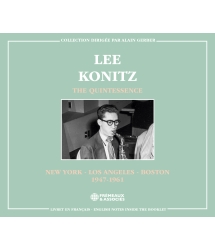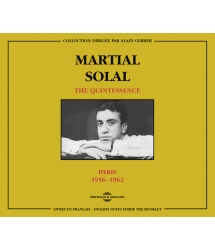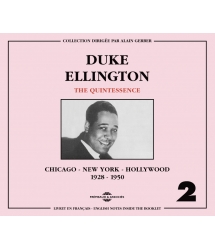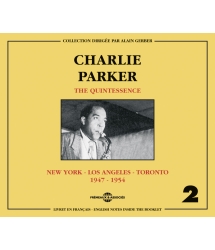- Our Catalog
- Philosophy
- Philosophers of the 20th century and today
- History of Philosophy (PUF)
- Counter-History and Brief Encyclopedia by Michel Onfray
- The philosophical work explained by Luc Ferry
- Ancient thought
- Thinkers of yesterday as seen by the philosophers of today
- Historical philosophical texts interpreted by great actors
- History
- Books (in French)
- Social science
- Historical words
- Audiobooks & Literature
- Our Catalog
- Jazz
- Blues
- Rock - Country - Cajun
- French song
- World music
- Africa
- France
- Québec / Canada
- Hawaï
- West Indies
- Caribbean
- Cuba & Afro-cubain
- Mexico
- South America
- Tango
- Brazil
- Tzigane / Gypsy
- Fado / Portugal
- Flamenco / Spain
- Yiddish / Israel
- China
- Tibet / Nepal
- Asia
- Indian Ocean / Madagascar
- Japan
- Indonesia
- Oceania
- India
- Bangladesh
- USSR / Communist songs
- World music / Miscellaneous
- Classical music
- Composers - Movie Soundtracks
- Sounds of nature
- Our Catalog
- Youth
- Philosophy
- News
- How to order ?
- Receive the catalog
- Manifesto
- Dictionnary











- Our Catalog
- Philosophy
- Philosophers of the 20th century and today
- History of Philosophy (PUF)
- Counter-History and Brief Encyclopedia by Michel Onfray
- The philosophical work explained by Luc Ferry
- Ancient thought
- Thinkers of yesterday as seen by the philosophers of today
- Historical philosophical texts interpreted by great actors
- History
- Books (in French)
- Social science
- Historical words
- Audiobooks & Literature
- Our Catalog
- Jazz
- Blues
- Rock - Country - Cajun
- French song
- World music
- Africa
- France
- Québec / Canada
- Hawaï
- West Indies
- Caribbean
- Cuba & Afro-cubain
- Mexico
- South America
- Tango
- Brazil
- Tzigane / Gypsy
- Fado / Portugal
- Flamenco / Spain
- Yiddish / Israel
- China
- Tibet / Nepal
- Asia
- Indian Ocean / Madagascar
- Japan
- Indonesia
- Oceania
- India
- Bangladesh
- USSR / Communist songs
- World music / Miscellaneous
- Classical music
- Composers - Movie Soundtracks
- Sounds of nature
- Our Catalog
- Youth
- Philosophy
- News
- How to order ?
- Receive the catalog
- Manifesto
- Dictionnary
5-7-9 MARS / 19 AVRIL 1960
Quincy Jones
Ref.: FA5460
EAN : 3561302546025
Label : Frémeaux & Associés
Total duration of the pack : 2 hours 34 minutes
Nbre. CD : 2
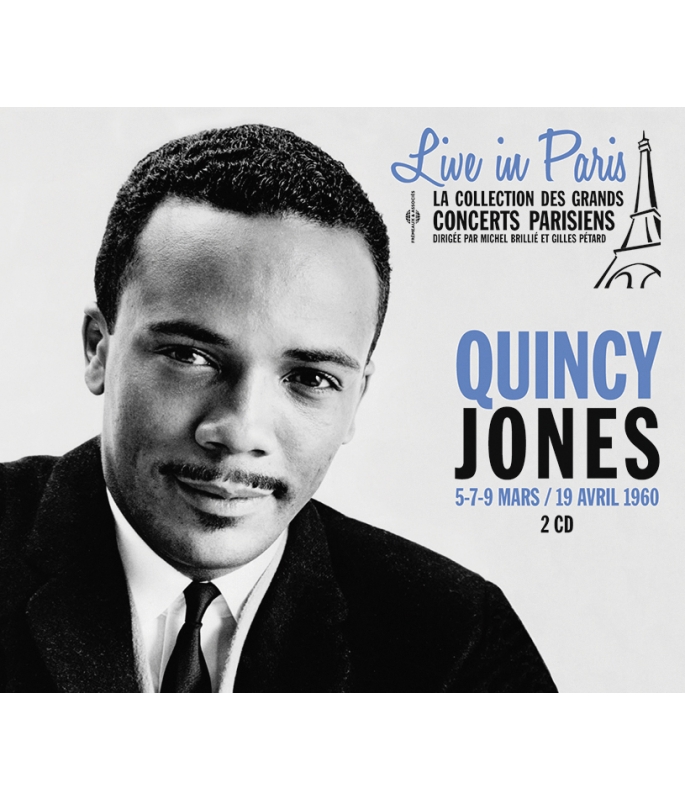
5-7-9 MARS / 19 AVRIL 1960
5-7-9 MARS / 19 AVRIL 1960
Quincy Jones, the great bandleader, arranger and trumpeter, was merely 25 years old when he decided to settle in a city with a taste for jazz that was close to cult-worship: Paris. Quincy studied under Nadia Boulanger and became a regular figure in Saint Germain-des-Près; he worked for Eddie Barclay, and also led sessions for Henri Salvador and The Double Six, who devoted a whole album to Quincy’s compositions. With the aid of Frank Ténot and Daniel Filipacchi, in 1960 he set up his own Big Band with 17 American musicians in a venture that was short-lived despite the immense artistic quality of the formation. The live album they recorded shows all the vitality and genius of the young arranger who, in only a few years, went on to become an essential figure in 20th century music, and its greatest pop producer thanks to his association with the legendary Michael Jackson. Patrick FRÉMEAUX
The Live in Paris collection by Michel Brillié allows listeners to hear previously-unreleased recordings (made at concerts and private- or radio-sessions) by the great 20th stars in jazz, rock & roll and song.
These “live” takes, and the artists’ rapport with their audiences, gives these performances an additional soul and sensibility in counterpoint to the rigorous demands of studio recordings. Particular care was taken when restoring the sound of these tapes in order to meet CD standards while preserving the original colours of the period.
Patrick FRÉMEAUX & Gilles PÉTARD
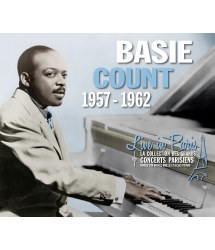
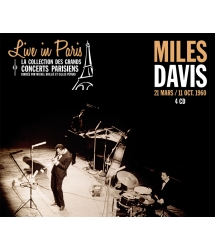
LIVE IN PARIS - 21 MARS / 11 OCTOBRE 1960
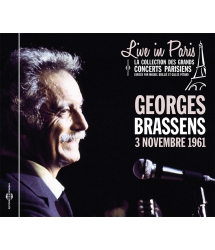
LIVE IN PARIS (3 NOVEMBRE 1961)
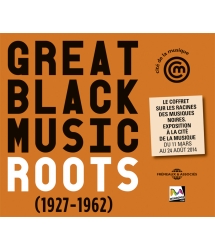
LES RACINES DES MUSIQUES NOIRES. EXPOSITION À LA CITÉ...
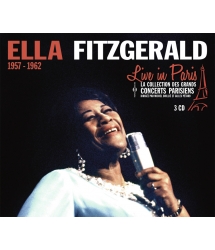
1957-1962





-
PisteTitleMain artistAutorDurationRegistered in
-
1Chinese CheckersThe Quincy Jones Big Band00:02:501960
-
2Sunday Kind Of LoveThe Quincy Jones Big BandBarbara Belle00:03:151960
-
3Air Mail SpecialThe Quincy Jones Big Band00:02:551960
-
4Parisian ThorouhfareThe Quincy Jones Big BandBud Powell00:04:361960
-
5The Phantom's BluesThe Quincy Jones Big BandErnie Wilkins00:08:481960
-
6Lester Leaps InThe Quincy Jones Big Band00:07:171960
-
7I Remember CliffordThe Quincy Jones Big Band00:03:111960
-
8Moanin'The Quincy Jones Big Band00:03:211960
-
9Doodlin'The Quincy Jones Big Band00:10:071960
-
10The GypsyThe Quincy Jones Big BandBilly Reid00:04:151960
-
11Big RedThe Quincy Jones Big BandErnie Wilkins00:04:411960
-
12Birth Of A BandThe Quincy Jones Big BandQuincy Jones00:04:211960
-
13Walkin'The Quincy Jones Big BandRichard Carpenter00:10:531960
-
14Air Mail Special Alternate Bonus Concert TrackThe Quincy Jones Big Band00:02:591960
-
15I Remember Clifford Alternate Bonus Concert TrackThe Quincy Jones Big Band00:03:541960
-
PisteTitleMain artistAutorDurationRegistered in
-
1The PreacherThe Quincy Jones Big Band00:03:251960
-
2Birth Of A BandThe Quincy Jones Big BandQuincy Jones00:04:591960
-
3My RêverieThe Quincy Jones Big BandL. Clinton00:04:121960
-
4GhanaThe Quincy Jones Big Band00:04:561960
-
5CherokeeThe Quincy Jones Big BandR. Noble00:03:311960
-
6Pleasingly PlumpThe Quincy Jones Big BandNeal Hefti00:03:131960
-
7Stockholm SweeteningThe Quincy Jones Big Band00:06:191960
-
8Tickle ToeThe Quincy Jones Big BandJon Hendricks00:02:511960
-
9Blues In The NightThe Quincy Jones Big BandJohnny Mercer00:05:161960
-
10Our Love Is Here To StayThe Quincy Jones Big BandGeorge And Ira Gerschwin00:03:241960
-
11Doodlin Feat Clark TerryThe Quincy Jones Big Band00:14:481960
-
12Ghana Alternate Bonus Concert TrackThe Quincy Jones Big Band00:04:501960
-
13Whisper Not Alternate Bonus Concert TrackThe Quincy Jones Big Band00:04:011960
-
14Birth Of A Band Alternate Bonus Concert TrackThe Quincy Jones Big Band00:04:251960
-
15Lester Leaps In Alternate Bonus Concert TrackThe Quincy Jones Big Band00:07:131960
CLICK TO DOWNLOAD THE BOOKLET
Quincy Jones FA5460
Live in Paris
La collection des grands concerts parisiens
Dirigée par Michel Brillié et Gilles Pétard
QUINCY JONES
5-7-9 MARS / 19 AVRIL 1960
Quincy Jones - LIVE IN PARIS
« Ooh là là ! » pétille Quincy Jones en face de Johnny Davis, le journaliste du Guardian, le quotidien de Londres qui l’interviewe ce jour de Septembre 2010 sur sa vie et sa carrière. Le musicien-compositeur-chef d’orchestre-arrangeur-producteur fait référence à son premier séjour à Paris, en 1957. Le jeune trompettiste s’est installé à Neuilly en avril de cette année pour étudier la musique avec la grande Nadia Boulanger. Il y restera jusqu’en novembre 1958, fréquentant le tout Paris, de Picasso à Brigitte Bardot. « C’était la fête tous les soirs avec Jeanne Moreau, Brigitte, Catherine Deneuve, » révèle le musicien à Paris Match en Octobre 2010. « Mais c’était Juliette Gréco qui me faisait craquer. J’ai eu une histoire avec elle en même temps que Miles Davis. Mais lui ne le savait pas. Je ne suis pas sûr qu’il l’aurait pris avec humour ! ». Mais Quincy à Paris est surtout le producteur à la mode, dirigeant les enregistrements d’Henri Salvador (« Blouse du dentiste » chez Barclay, où « Q » est directeur artistique, sur un texte de Boris Vian) au groupe vocal Les Double Six, qui consacrent un album entier à ses compositions.
Quincy Jones devient aussi ami avec les deux jazz fans les plus connus du moment, Frank Ténot et Daniel Filipacchi. Ils font un peu la pluie et le beau temps dans ce domaine musical, avec leur émission quotidienne sur Europe N°1, « Pour ceux qui aiment le jazz » et « Jazz Magazine », la revue qu’ils viennent de racheter à Barclay. Daniel, toujours photographe, réalise la photo de couverture du numéro de Juillet-Aout 1957, celle où Quincy barbote sur un bord de plage avec sa petite fille sur le dos. Dans son autobiographie iconoclaste « Ceci n’est pas une autobiographie », en clin d’œil au tableau de Magritte « Ceci n’est pas une pipe » qui montre justement…une pipe, Daniel raconte :
« Quincy Jones, tout jeune homme, faisait un complexe car il était troisième trompettiste aux côtés du génial Clifford Brown dans le Big Band de Lionel Hampton. Je plaisantai :
- Forme ton propre orchestre. » 1
Quincy Jones revient en France deux ans plus tard. Avec un grand orchestre. C’est une opportunité magique : fin 1959, Harold Arlen et Johnny Mercer l’ont engagé pour diriger le Big Band de leur nouvelle comédie musicale, « Free and Easy ». Arlen est un vétéran de Broadway, il a déjà écrit les musiques de « Stormy Weather » et du « Magicien d’Oz ». Mercer est l’auteur de « Blues in the Night » ou « Come Rain or Come Shine ». Des pros… Avec une idée saugrenue : celle de rôder leur musical en Europe, avant de le monter à Broadway. Le spectacle est original, l’orchestre de dix-huit musiciens est partie intégrante du décor, la pièce se déroulant dans un saloon, le Rocking Horse, à Saint Louis, au début du siècle. Les musiciens sont costumés et font partie de la figuration. Les deux rôles principaux sont tenus par Irene Williams et le fabuleux Harold Nicholas.
La première mondiale de ce « blues drama » a lieu le 15 janvier 1960, au théâtre de l’Alhambra, à Paris. Mais l’époque n’est pas à la frivolité. La France est en plein dans le conflit algérien. Un encart dans le quotidien américain de Paris le « New York Herald Tribune » avertit ses lecteurs que « toute personne au teint basané doit éviter de se trouver sur la voie publique après 18h. » Quincy se souvient dans son autobiographie que plusieurs de ses musiciens se sont faits arrêtés et contrôlés par des CRS armés de mitraillettes.
Le show devait tenir deux mois à Paris. Il s’arrête au bout de six semaines. Quincy et son Big Band sont sur le sable, il doit absolument trouver 4800 dollars par semaine pour nourrir et héberger pas loin de 30 personnes – plusieurs membres de l’orchestre sont venus avec famille ou avec leur girlfriend. « Q » se trouve vers son ami Daniel :
- Eh bien maintenant, il faut que tu nous trouves du boulot. 1
Daniel loue avec Frank le grand Studio Barclay, 9 avenue Hoche, dans le quartier de la place de l’Etoile, à Paris. C’est presque une petite salle de spectacle, vue la taille, où viennent enregistrer en direct les grands noms de la chanson française, Aznavour, Brel - Les Chaussettes Noires d’Eddy Mitchell… Et Quincy Jones : du 27 au 29 Février 1960, il y a déjà enregistré son album «I Dig Dancers », un recueil de mélodies plutôt commerciales, sans doute pour tenter de renflouer les finances du Big Band. En Mars, pendant une semaine, Quincy se produit tous les jours au studio Hoche transformé au club de jazz « devant trois pelés et un tondu » 1, écrit Daniel. Car malgré un intense lobbying de la communauté des expat’ américains de la capitale, le public, certes enthousiaste et connaisseur, reste maigre… Mais Quincy en profite pour parfaire le son de son orchestre, et donner des versions améliorées des compositions de ses précédents albums, « Birth of a Band » et « The Great Wide World of Quincy Jones ».
« Autour d’un jeune chef, l’union des styles » écrit Frank Ténot dans un grand article de Jazz Magazine (N°56, Février 1960) « Quincy Jones face à son destin ». Ce « jeune homme charmant, qui présente bien, fort joli garçon » réunit jeunes loups et vétérans : le trombone Quentin Jackson a alors 50 ans, Clark Terry (trompette) 40, l’alto sax Phil Woods 29… Les sets enregistrés à Hoche démontrent la liberté que Jones donne à ses solistes, notamment dans ce « Doodlin’ » d’Horace Silver où Clark Terry se lance dans une improvisation blues débridée. Et l’entente avec l’audience est remarquable : on est quasiment dans un club de New-York, « Birdland sur Seine » avec tintements de verre et rires féminins…
Même si Daniel Filipacchi et Frank Ténot « piochent profondément dans leurs poches pour que Quincy puisse payer son équipe et continuer à faire sa bonne musique » 1, Quincy doit s’improviser impresario et trouver des « gigs », des engagements, pour survivre. Il s’associe avec un jeune tourneur français qui empoche des avances sur seize concerts dans l’hexagone puis disparaît avec le cash. S’ensuit alors une errance de plusieurs mois du Big Band à travers l’Europe : Hollande, Belgique, Italie, Autriche, Yougoslavie, Allemagne, Finlande, Suède… « Nous allions de ville en ville, comme des bohémiens, » raconte Quincy. « En train, en voiture, en car...et même à pied, une fois, en Yougoslavie. Le bus est arrivé à un pont qui ne supportait pas un tel poids, alors le chauffeur nous a fait descendre, hommes femmes, enfants, chiens, et on a traversé à pied en portant bagages et instruments. » 2
Au hasard de tous ces zigzags continentaux, Quincy Jones et sa troupe se retrouve en avril à Paris pour un concert à l’Olympia. Cette fois-ci le public est venu : la couverture « Un grand orchestre est né » et l’article de dix pages de « JazzMag » consacré à Quincy ont dû faire leur effet.
En se retournant sur ces années parfois mouvementées en France dans « Quincy », son autobiographie, Quincy Jones évalue ainsi sa relation particulière avec le pays :
« En France, j’ai enfin pu embrasser mon passé, mon présent et mon avenir en tant qu’artiste et homme de couleur, et j’ai étendu ma perception de la condition humaine, tant dans le domaine artistique que dans la vie, ce qui m’a aidé par la suite à comprendre le marché mondial dans le domaine des affaires. Je me suis senti à ma place en tant que citoyen du monde. La France m’a traité en artiste. Des années plus tard, en 1991, j’ai été intronisé dans l’Ordre de la Légion d’Honneur, créé en 1802 par Napoléon. Grâce à la France, je me suis enfin senti libre et heureux d’être moi-même. » 2
Michel BRILLIE
1. « Ceci n’est pas une autobiographie » Daniel Filipacchi, Bernard Fixot Editions, 2012
2. « Quincy », par Quincy Jones, Traduction Mimi et Isabelle Perrin, Robert Laffont, 2003
Dédié à Claude Boquet, Bill Dubois, Jean Claude, Philippe Moch et toute la bande.
© FRÉMEAUX & ASSOCIÉS 2014
Quincy Jones - LIVE IN PARIS
“Ooh là là!” twinkles Quincy Jones on this September 2010 day. Interviewed by Johnny Davis, a journalist for the British daily newspaper The Guardian, the musician-composer- bandleader - arranger – producer reminisces his early days in Paris, in 1957. The young 25 year-old trumpet player had settled in Neuilly, in the western suburbs of the city, to be able to study music with the famous Nadia Boulanger. He is to remain in France until November 1958, becoming a true jet-setter in the “Tout Paris” circuit, mingling with Picasso or Brigitte Bardot. “I partied every night with Jeanne Moreau, Brigitte, Catherine Deneuve”, the musician tells Paris Match magazine in October 2010. “But I had a real crush on Juliette Gréco. I even had an affair with her at the same time she was Miles Davis’s big french love... But he never found out about it. I’m not so sure he would have taken it with a smile!”. In Paris, Quincy is most of all the hip producer of the time : for Barclay Records, he directs sessions with various French artists, among which Henri Salvador (“Blouse du Dentiste” with lyrics by French writer Boris Vian), and Les Double Six, a vocal group influenced by Lambert, Hendricks and Ross, who record an entire album of his compositions.
Quincy Jones also quickly becomes a friend of the top jazz fans of the period, Frank Ténot and Daniel Filipacchi. They dominate the Parisian jazz scene, with their daily radio show on Europe N°1 station, “Pour ceux qui aiment le Jazz.” (For You Jazz Diggers) and their monthly jazz review, Jazz Magazine, recently bought from Eddie and Nicole Barclay. Daniel, a photographer, shoots the cover of the July-August 1957 issue, which shows Quincy on a French beach with his young daughter on his back. In his provocative autobiography “This is not an autobiography” (in reference to Magritte’s painting “This is not a pipe”, that shows… a pipe) Daniel recalls his early encounter with Quincy:
“Quincy, then a young musician, felt under-estimated as a third rank trumpeter in Lionel Hampton’s band, overshadowed by the great Clifford Brown. I kidded him:
- Get your own band together.” 1
Two years later, Quincy is back in France, with his all new Big Band. It’s a magic opportunity: at the end of 1959, Harold Arlen and Johnny Mercer booked him to become the leader of the orchestra for their newest musical, “Free and Easy”. Arlen is a Broadway celebrity, having already composed “Stormy Weather” and the music of “The Wizard of Oz”. Mercer has penned songs such as “Blues in the Night” or “Come Rain or Come Shine”. A couple of real pros, with a strange idea: the plan was to get the show in shape in Europe, and then take it to London and finally Broadway. The musical was lots of fun, the full 18 piece orchestra being in costume, and part of the show. The play is set in a turn-of-the-century saloon in Saint Louis, the “Rocking Horse”. The leading parts are played by Irene Williams and Harold Nicholas, the amazing American tap-dancer.
The world premiere of the “blues drama” takes place on January 15, 1960 at the Alhambra Theater in Paris. But times are hard in France, deep in the midst of the Algerian crisis. The American newspaper in Paris “The New-York Herald Tribune” runs a notice on page 1 that says “Any swarthy-complexioned person is advised to stay off the street after six o’clock in the evening.” Quincy remembers that several members of the band, going to and from the theater, were stopped by policemen armed with machine-guns.
Right away, the show loses money, and folds six weeks after, just short of the two months crucial period. Quincy and his band are without resources: he needs to find 4.800 dollars per week to support some thirty persons, some of the members in the band travelling with wives, children, or girlfriends. Quincy then turns to his friend Daniel:
- Well now, you’ve got to find us some work…1
Daniel and Frank rent the Studio Barclay , located at 9 Avenue Hoche in the Place de l’Etoile area in Paris. It’s a very large hall where the top singers in the French chanson come to record their works, Jacques Brel, Charles Aznavour – some French rock groups also. And Quincy Jones: there, from February 27 to 29, 1960 he has already recorded his newest album “I Dig Dancers”, a collection of commercial tunes, perhaps to help the finances of the Big Band. At the beginning of the month of March, Quincy and the band performs at Studio Hoche on a daily basis, “in front of one man and his dog”1 as Daniel Filipacchi recalls. In spite of an intense lobbying from the expatriate American community, the audience, though enthusiastic jazz experts, remains scarce. But Quincy has an opportunity to break his band in and develop its sound, and to refine improved versions of his compositions featured on the albums “Birth of a Band” and “The Great Wide World of Quincy Jones”.
“Around this young leader, there is an unity of styles” writes Frank Ténot in “Quincy Jones faces his destiny”, a eight-page article in the February 1960 issue of Jazz Magazine. “This charming, personable and handsome young man” has gathered ambitious youngsters and veterans: trombone player Quentin Jackson is fifty, trumpeter Clark Terry forty , altosaxman Phil Woods twenty-nine…The sets recorded at Hoche Studio show the freedom that Jones gives to his men, as in this version of Horace Silver’s “Doodlin’” with an unrestrained blues improvisation by Clark Terry. The audience is fully attuned with the band, like in a Paris version of the New-York “Birdland” club, clicking of glasses and female laughter included.
But, even if Frank and Daniel “dig deep in their pockets to support Quincy and enable him to continue performing his great music”1, Jones realizes that he has to act as road manager and agent to find gigs to survive. He meets a young French promoter, who lines up sixteen dates for the band in France, gets advance money for them, and vanishes with the cash.
Thereafter follows a period of intense traveling throughout Europe for the band: “We did Holland, Belgium, Italy, Yugoslavia, Finland, Austria, Germany, Sweden, back to Germany, back to France, Switzerland, over to Portugal again, jamming, doing the best we could. We went from town to town like gypsies, traveling by bus, train, car – we even traveled on foot at one point in Yugoslavia. The bus came to a bridge that couldn’t support the weight of those people. The bus driver made us get off, and men, women, children, and dogs walked over the bridge carrying their luggage and instruments.”2
Amidst this crisscrossing of the European continent, “Q” and his gang return to the French capital in April for a date at the Olympia Theater. This time the audience is here: The cover of the issue of Jazz Magazine with “A great band is born” and the eight page piece on Quincy did the job.
Looking back on all those turbulent years in France, Jones evaluates thus his particular relationship with the country in his book: “In France I was able to envision my past, present and future as an artist and as a black man; I took a wider view of the human condition that extended to both art and life., and later helped me to take stock of global markets in business dealings. …/… I became comfortable as a citizen of the world. France treated me like an artist. Years later, in 1991, France inducted me into the Legion of Honor, an award that began in 1802 with Napoleon. France made me feel free, and glad to be who I was.” 2
Michel BRILLIE
1. “Ceci n’est pas une autobiographie” Daniel Filipacchi, Bernard Fixot Editions, 2012
2. “Q: The Autobiography of Quincy Jones” by Quincy Jones, Random House, 2001
Dedicated to Claude Boquet, Bill Dubois, Jean Claude, Philippe Moch and the gang.
© FRÉMEAUX & ASSOCIÉS 2014
CD 1
The Quincy Jones Big Band Live in Paris
Live March 5-7-9, 1960
Recording Place : Barclay Hoche Studio, Paris France
Produced by: Frank Ténot & Daniel Filipacchi
1. Chinese Checkers (David Carr Glover) 2’50
2. Sunday Kind of Love (Barbara Belle / Anita Leonard / Stan Rhodes /Louis Prima / Barbara Belle / Anita Leonard / Stan Rhodes /Louis Prima) 3’15
3. Air Mail Special (Charlie Christian / Benny Goodman / James Mundy) 2’55
4. Parisian Thoroughfare (Bud Powell) 4’36
5. The Phantom’s Blues (Ernie Wilkins) 8’48
6. Lester Leaps in (Lester Young) 7’17
7. I Remember Clifford (Benny Golson) 3’11
8. Moanin’ (Bobby Timmons) 3’21
9. Doodlin’ (Horace Silver) 10’07
10. The Gypsy (Billy Reid/Billy Reid) 4’15
11. Big Red (Ernie Wilkins) 4’41
12. Birth of a Band (Quincy Jones) 4’21
13. Walkin’ (Richard Carpenter) 10’53
14. Air Mail Special [Alternate Bonus Concert Track] (Charlie Christian / Benny Goodman / James Mundy) 2’59
15. I Remember Clifford [Alternate Bonus Concert Track] (Benny Golson) 3’54
CD 2
The Quincy Jones Big Band Live in Paris
Tracks 1 to 4: April 19, 1960
Tracks 5 to 15: March 5-7-9, 1960
Produced by: Frank Ténot & Daniel Filipacchi
Recording Places
Tracks 1 to 4: Olympia Theater, Paris, France
Tracks 5 to 15: Barclay Hoche Studio, Paris France
1. The Preacher (Horace Silver) 3’25
2. Birth of a Band (Quincy Jones) 4’59
3. My Reverie (Larry Clinton / Claude Debussy) 4’12
4. Ghana (Ernie Wilkins) 4’56
5. Cherokee (Ray Noble / Ray Noble) 3’31
6. Pleasingly Plump (Neal Hefti) 3’13
7. Stockholm Sweetening (Quincy Jones) 6’19
8. Tickle Toe (Jon Hendricks / Lester Young) 2’51
9. Blues in the Night (Johnny Mercer / Harold Arlen) 5’16
10. Our Love is Here to Stay (Ira Gershwin / George Gershwin) 3’24
11. Doodlin’ feat. Clark Terry (Horace Silver) 14’48
12. Ghana (Ernie Wilkins) [Alternate Bonus Concert Track] 4’50
13. Whisper Not (Benny Golson) [Alternate Bonus Concert Track] 4’01
14. Birth of a Band (Quincy Jones) [Alternate Bonus Concert Track] 4’25
15. Lester Leaps in (Lester Young) [Alternate Bonus Concert Track] 7’13
Personnel
Benny Bailey: Trumpet • Patti Bown: Piano • Buddy Catlett: Bass, Bass (Acoustic)
Jimmy Cleveland: Trombone • Joe Harris: Drums, Guest Artist • Quentin Jackson: Trombone
Budd Johnson: Sax (Tenor), Saxophone • Leonard Johnson: Trumpet
Quincy Jones: Arranger, Bandleader • Porter Kilbert: Saxophone • Melba Liston: Trombone
Ake Persson: Trombone • Jerome Richardson: Sax (Tenor), Saxophone
Sahib Shihab: Saxophone • Les Spann: Flute, Guitar • Floyd Standifer: Trumpet
Clark Terry: Flugelhorn, Trumpet, Vocals • Julius Watkins: French Horn
Phil Woods: Sax (Alto), Saxophone
Quincy Jones, formidable conducteur d’orchestre, arrangeur et trompettiste, décide à même pas 26 ans de venir s’installer à Paris, qui voue alors un véritable culte pour le jazz. Élève de Nadia Boulanger, il fréquente le tout Saint-Germain-des-Près, travaille pour Eddie Barclay et dirige des enregistrements d’Henri Salvador et des Double Six, qui consacrent un album entier à ses compositions. Avec l’aide de Frank Ténot et Daniel Filipacchi, il monte en 1960 son propre Big Band avec 17 musiciens américains, l’aventure sera courte malgré la grande qualité artistique de l’ensemble. Un live qui témoigne de toute la vitalité et du génie du jeune orchestrateur, qui deviendra en quelques années une figure incontournable de la musique populaire du XXe siècle et le plus grand producteur de la pop music, avec son légendaire interprète, Michael Jackson.
Patrick FRÉMEAUX
Quincy Jones, the great bandleader, arranger and trumpeter, was merely 25 years old when he decided to settle in a city with a taste for jazz that was close to cult-worship: Paris. Quincy studied under Nadia Boulanger and became a regular figure in Saint-Germain-des-Près; he worked for Eddie Barclay, and also led sessions for Henri Salvador and The Double Six, who devoted a whole album to Quincy’s compositions. With the aid of Frank Ténot and Daniel Filipacchi, in 1960 he set up his own Big Band with 17 American musicians in a venture that was short-lived despite the immense artistic quality of the formation. The live album they recorded shows all the vitality and genius of the young arranger who, in only a few years, went on to become an essential figure in 20th century music, and its greatest pop producer thanks to his association with the legendary Michael Jackson.
Patrick FRÉMEAUX
La collection Live in Paris, dirigée par Michel Brillié, permet de retrouver des enregistrements inédits (concerts, sessions privées ou radiophoniques), des grandes vedettes du jazz, du rock & roll et de la chanson du XXe siècle. Ces prises de son live, et la relation avec le public, apportent un supplément d’âme et une sensibilité en contrepoint de la rigueur appliquée lors des enregistrements studios. Une importance singulière a été apportée à la restauration sonore des bandes, pour convenir aux standards CD tout en conservant la couleur d’époque.
Patrick FRÉMEAUX & Gilles PÉTARD
The Live in Paris collection by Michel Brillié allows listeners to hear previously-unreleased recordings (made at concerts and private- or radio-sessions) by the great 20th stars in jazz, rock & roll and song. These “live” takes, and the artists’ rapport with their audiences, gives these performances an additional soul and sensibility in counterpoint to the rigorous demands of studio recordings. Particular care was taken when restoring the sound of these tapes in order to meet CD standards while preserving the original colours of the period. Patrick FRÉMEAUX & Gilles PÉTARD
CD Quincy Jones Live in Paris 5-7-9 mars/19 avril 1960, Quincy Jones © Frémeaux & Associés 2014
